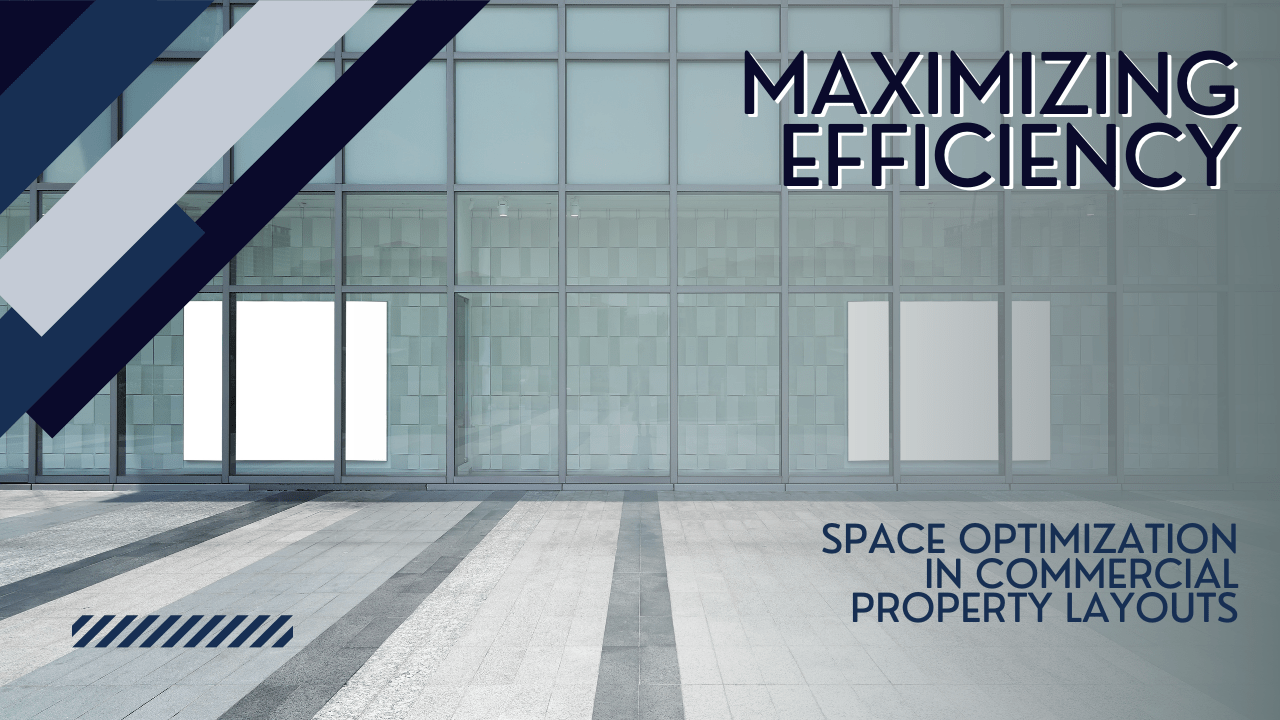Space is at a premium throughout California, and it’s possible you could be doing more with your commercial property to optimize the square footage you have.
There’s been a lot of talk about space optimization lately, and thinking about this has many benefits. By using space wisely, you can enhance the productivity in your building, attract high-quality commercial tenants, and significantly increase the value of your commercial investments. Many owners have found that by designing functional and flexible spaces, businesses can more easily flourish.
If you want to maximize the efficiency of your space, you’ll have to consider your building design, your floor plans, and the potential for renovations and improvements. Think about your ideal commercial tenants, too, and the type of space that they’ll be looking for.
At Bell Properties Commercial Real Estate, we are frequently helping commercial investors in California maximize the aesthetics and the functionality of their spaces, whether it’s retail, industrial, medical, or office space. Let’s take a look at some of the recommendations we’re frequently making for space optimization and building efficiency.
Capitalize on the New Trend in Multi-Purpose Space
Maybe it’s not a new trend, per se, but it’s one that’s really getting a lot more attention among commercial developers recently. As you’re in the design process of your existing commercial building’s floor plan or considering what you might acquire next, make sure you’re looking at the integration of multi-purpose spaces, particularly if your business model benefits from offering your tenants versatile environments.
Offering a floor plan that can accommodate different functions and even different industries can help you maximize efficiency and space. This works for any type of commercial building or campus. Allowing space in one building for multiple tenant types, business operations, and purposes will reduce the need for several separate buildings, for example. Dual purposes will help you earn more money and attract diverse tenants.
When you’re looking to create an efficient floor plan that uses up every available square inch, considering multi-purpose activities and rentals will help you make the most of your square footage and your space. Make sure there’s a smooth flow from business to business. If there’s a tenant who would do well with an open-air setting, consider letting them set up in the middle of a lobby. As long as the existing tenants don’t feel threatened by competition, it can actually drive more business towards your current commercial renters.
This is also a good way to estimate what kind of potential there is for expansion or adaptations. If you’ve got a flexible space that’s already meeting diverse needs, significant and costly renovations likely won’t be necessary in the future. You’re already working with a fluid concept.
We like the idea of enhancing the functionality of your entire building, giving each space, section, or corner the opportunity to serve more than one purpose.
Consolidate Commercial Space When You Can
Consolidation and eliminating unnecessary wasted space can help you maximize what you have and create a commercial space that’s likely to attract more tenants and offer more business. Here are some examples of how you can consolidate and reduce:
Maximize efficiency and reduce construction costs by strategically grouping together all areas rented by tenants who need similar services, such as internet or plumbing. This will eliminate extra construction costs. Why put one plumbing core across the building and on a separate floor when you can just use one such core to meet all the plumbing needs of your clustered commercial tenants?
Keep bathrooms close to supply closets where you’ll keep toilet paper, hand towels, and cleaning supplies.
Merging similar function areas allows you to free up space for more critical uses like product displays or co-working spaces, directly contributing to the better experience of your tenants.
Eliminating redundant spaces and consolidating similar spaces can keep construction and renovation costs down, make long-term maintenance more affordable, and keep your commercial property more cost-effective in general.
When you have a building full of diverse and profitable tenants, maximize space for yourself and for them by offering amenities that will best serve their needs. A fitness room might be extremely attractive for commercial tenants with employees who may want to exercise on their lunch breaks or right after work. It’s also a new revenue stream for you.
Maybe a receptionist or a security desk is a good way to utilize the space at the front door. This is a great perk for your tenants, and it also allows for a monitored system of tracking who is coming and going.
Or, consider the addition of a central lounge or lobby, which can be used as an extra meeting space can be the best place for your tenants to have impromptu meetings or enjoy their downtime. Such amenities not only keep your commercial tenants engaged and productive, but they counter turnover and can attract new business.
Traffic Patterns Inside and Outside of Your California Commercial Property
As you evaluate where you can maximize your space efficiency, consider your traffic patterns. Where do people move and how do they move when they’re inside your commercial space? You need a commercial floor plan that supports a natural and instinctive flow. Your tenants will not want to rent your space if they worry that their customers will show up and immediately feel like they’re lost in some kind of nonsensical maze. Envision the flow of foot traffic throughout the facility and see if there’s room for improvement.
Check your layout for potential obstructions. Are you finding excessive walls, weird separations, or unclear paths that might hinder the movement between different areas of the building? If it’s a multi-floor building, are the elevators easy to find? What about the stairs?
A traffic pattern that makes sense will increase the customer experience and stabilize your operational functionality.
Is there enough space for things like restrooms, fitting rooms in a retail space, demo areas in a public-facing business, and storage in a warehouse? Think about not only your tenants but their customers, employees, and visitors. Does it all make sense?
Use of Flexible Furniture
Are you offering commercial space that is furnished or unfurnished? This is an important part of how you market your property to commercial tenants. What are they looking for?
While your tenants looking for office space are likely to bring their own desks and bookcases and your retail tenants will surely show up with their own mirrors and shelving, you might want to consider implementing flexible furniture solutions such as movable walls and adjustable built-in structures. These types of things allow tenants to customize their space according to their needs, working with what you’ve already provided.
Incorporating Technology and Sustainable Design
Smart building technologies can play a significant role in space optimization. Internet of Things (IoT) devices can monitor space utilization in real-time, providing valuable insights for better space management. We strongly recommend investing in this type of technology, which can not only maximize the space you’re using, but also alert you to things like water leaks, appliances that were left on, and other potential dangers and maintenance concerns.
Incorporating green building practices not only appeals to environmentally conscious tenants but also can reduce operating costs through energy efficiency. California commercial tenants are concerned with their carbon footprint, and there are also state and local laws that will need to be followed around things like waste and toxic chemicals. Keeping your building compliant and sustainable is part of optimizing all of the space and systems you’re working with.
Benefits of Effective Space Optimization
How can space optimization help you as a commercial property owner in California?
Increased Productivity
Efficiently designed spaces can boost the productivity of your tenants, and that’s going to help you attract and keep business. Open layouts and intentional design promote collaboration among your tenants. When quiet zones are necessary, you can set up partitions and carve out space that reduces wasted square footage and redundant spaces. That will inspire more focused work and create a sense of privacy.
The designs you choose with space optimization in mind can cater to various work styles and tenant types, making it easier for people to perform at their best.
Higher Tenant Satisfaction
Keeping your commercial tenants happy is essential to your success and profitability. You’ll find that your tenants appreciate well-thought-out spaces that meet their needs. They’ll be eager to rent in a building that meets their needs and to work with a property owner who is willing to make renovations and approve build-outs to customize the space for them. Happy tenants are more likely to renew leases, ensuring a stable income for property owners and longevity for their investment success.
Increasing Property Value
 Optimized layouts can make a property more appealing, driving up demand and, consequently, its market value. This is particularly crucial in competitive markets like California. You want to earn as much as you can on your rental property for as long as possible, and making the types of renovations and upgrades that maximize space will help your building increase in appreciation and value.
Optimized layouts can make a property more appealing, driving up demand and, consequently, its market value. This is particularly crucial in competitive markets like California. You want to earn as much as you can on your rental property for as long as possible, and making the types of renovations and upgrades that maximize space will help your building increase in appreciation and value.
Let’s talk about your California commercial space and how to make the most of every bit of it. Please contact us at Bell Properties Commercial Real Estate.



